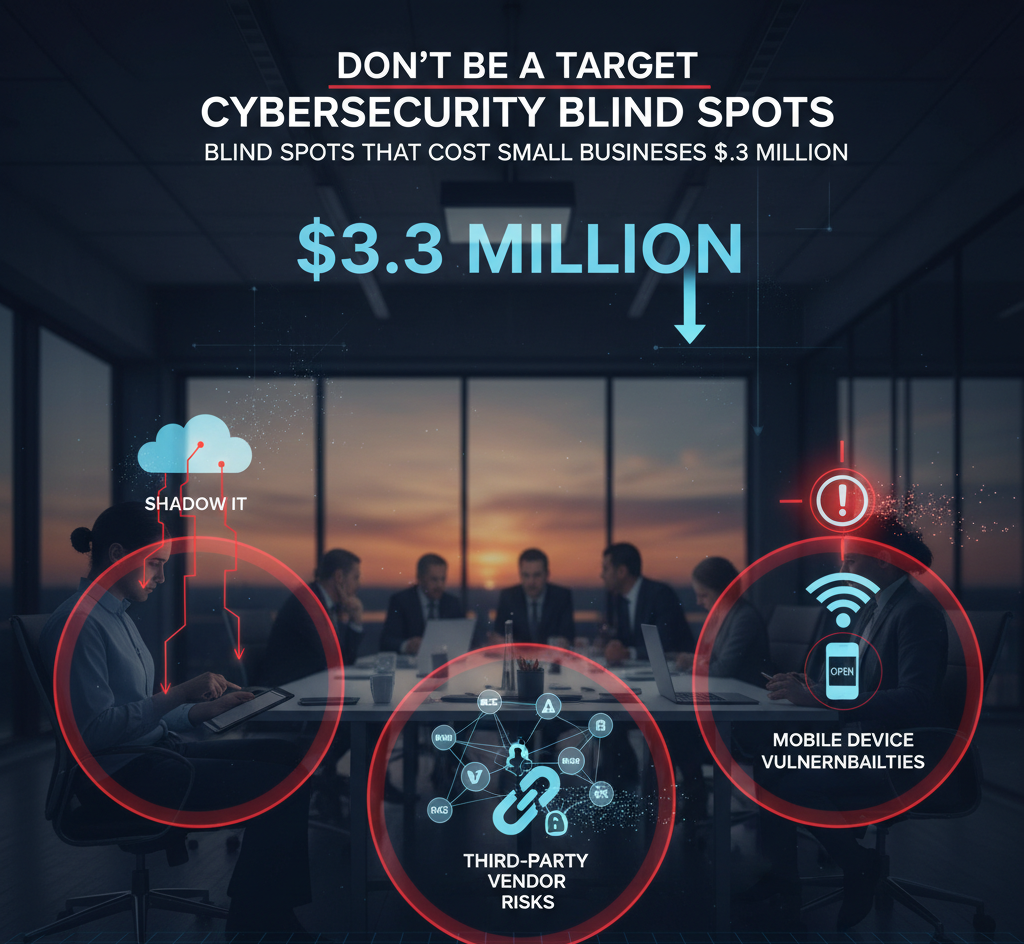Let me tell you something that’s going to shock you.
Here’s the stunning reality. Nearly half (47%) of businesses with fewer than 50 employees have zero budget allocated for cybersecurity. That lack of defense is why cybercriminals see you, specifically, as the perfect target.
And here’s the kicker, 36% of small business owners are not at all concerned about cyberattacks. You know what that tells me? Most business owners think they’re too small to matter.
But cybercriminals? They see you as the easiest target.
The Blind Spots That Are Costing You Sleep (And Money)
So here’s the thing, and I’m going to be honest with you. After working with hundreds of small businesses, I’ve noticed the same blind spots over and over. The scary part? Most executives have no idea these vulnerabilities even exist until it’s too late.
Case in point: A few months ago, a 15 person accounting firm came to us after their client data got compromised. You know what the entry point was? An employee’s personal iPad that he used for both work emails and his kid’s games. That iPad had been infected with malware for months, quietly siphoning emails. Total damage? $20,000 in forensics, legal fees, and lost clients.
Blind Spot #1: Shadow IT (The Apps You Don’t Even Know About)
Now, the other thing is Shadow IT, and this is where it gets really interesting. 85% of businesses have employees using unauthorized apps right now. We’re talking about a significant portion of your company’s applications being stuff you never approved.
Your team is using:
- Personal Dropbox accounts for “quick” file sharing
- WhatsApp for client communications
- Random project management tools they found online
- Personal cloud storage for work documents
Why does this happen? Because employees often say IT is too slow to respond to their needs. So they find their own solutions, and boom, you’ve got sensitive data scattered across platforms you can’t control.
The real cost: Companies waste an average of $135,000 annually on unnecessary SaaS tools they don’t even know about. But that’s nothing compared to the financial impact of a breach. Nearly one in two cyberattacks stem from Shadow IT, and the costs to fix them average more than $4.2 million.
Blind Spot #2: Third-Party Vendor Risks (Your Partners Are Your Weakest Link)
Here’s something that blew my mind. At least 35.5% of all data breaches in 2024 were linked to third party access. Think about that for a second. More than one in three breaches didn’t even start with your company; they came through someone you trusted.
Supply chain attacks were the second most prevalent attack vector in 2025, and they’re the second costliest at $4.91 million per incident. But get this, nearly half of all organizations suffered a third-party cyberattack or data breach in 2024.
So what that means is, your:
- Cloud hosting provider
- Email service
- Accounting software vendor
- Website developer
- Any contractor with system access
All of these could be your entry point for cybercriminals. In fact, third party data breaches have become a major concern, with 59% of organizations experiencing breaches tied to third party involvement.
I had a client, a construction company, who got hit because their project management software vendor got breached. Suddenly, all their project data, client contacts, and financial information was out there. The vendor never even told them about the breach for three weeks.
Blind Spot #3: Mobile Device Vulnerabilities (BYOD Gone Wrong)
Let’s talk about something most business owners completely ignore: mobile security. 92% of organizations now support some form of remote connectivity, making mobile devices critical business tools. The problem? A significant number of businesses report greater access to sensitive information via mobile devices than a year ago.
Your employees are accessing company email, documents, and systems from phones that might be:
- Running outdated software
- Infected with malware from sketchy apps
- Connected to unsecured public WiFi
- Backing up business data to personal iCloud accounts
And here’s what’s crazy. A large percentage of employees admit they knowingly take risky actions on their mobile devices. They know it’s dangerous, but they do it anyway because it’s convenient.
The Leadership Mindset Shift You Need to Make
So what that means is, cybersecurity isn’t just IT’s problem anymore. It’s a business risk conversation that belongs in the boardroom. When I see business owners treating cybersecurity as a “tech thing,” I know they’re missing the point.
Look at these numbers:
- 75% of small and midsize businesses couldn’t continue operating if hit with ransomware.
- Only 17% have cyber insurance (and 48% didn’t buy it until after an attack).
- 47% of businesses under 50 employees have zero cybersecurity budget.
The reason I bring this up is this: cybersecurity is now a competitive advantage. Businesses with strong security posture win more clients, get better insurance rates, and sleep better at night.
Your Quick Blind Spot Audit
Here are five questions every business owner should be able to answer today:
- Can you list every app and service your employees use for work? If not, you have Shadow IT.
- When did you last security assess your vendors? If it’s been over a year (or never), you’re exposed.
- Do you know what’s on every employee’s phone or laptop? Personal devices accessing company data need management.
- Who has access to what data? If you can’t draw this out on paper, you’re vulnerable.
- How fast could you detect and respond to a breach? If the answer is “I don’t know,” you need an incident response plan.
If you couldn’t answer three or more of these confidently, you’ve got Cybersecurity Blind Spots that need immediate attention.
Comparing Proactive vs. Reactive Security Costs for SMBs
The crazy part is, addressing these blind spots doesn’t require a massive investment. Here’s what proper visibility actually costs versus what blindness costs you:
Investment in Visibility (Proactive Cost):
- Shadow IT discovery and management: Included as part of your standard IT services.
- Vendor risk assessment tools: We include vendor assessment and continuous monitoring for our clients.
- Mobile device management (MDM): Should be a standard, required component of any managed endpoint service.
- Total for a 25-person business: No additional cost beyond your standard agreement, if you choose the right IT provider.
Cost of Staying Blind (Reactive Cost):
- Average breach cost for small businesses: Approximately $3.3 million in remediation, legal fees, and lost business.
- Business downtime: 50% of SMBs take 24 hours or longer to recover from an attack.
- Nearly 60% of small businesses that suffer a cyberattack shut down within six months.
You know what’s interesting? 29% of businesses that suffered a breach responded by hiring a cybersecurity firm. Why wait until after the damage is done?
Look, at the end of the day, you can’t protect what you can’t see. These Cybersecurity Blind Spots exist in every business, but the smart business owners are the ones who identify and fix them before they become expensive problems.
Ready to eliminate your Cybersecurity Blind Spots?
Book a 15-minute Cyber Strategy Call, and we’ll walk through a quick assessment to identify your biggest risks and show you exactly what needs attention first.
FAQ
Q: How do I know if my employees are using unauthorized apps (Shadow IT)?
A: You can’t rely on asking them nicely. Shadow IT discovery tools are the first step. These solutions scan your network traffic, cloud service logs, and email systems to identify unsanctioned applications your employees are using for work. Most businesses are shocked by what they find, but gaining this visibility is critical to controlling your data.
Q: What’s the fastest way to assess third-party vendor security risks?
A: Start by segmenting your vendors based on the sensitivity of the data they touch. For all vendors, use a simple vendor security questionnaire covering their data handling, incident history, and certifications. For mission-critical vendors, such as your cloud host or accounting platform, always request their SOC 2 reports. If they handle sensitive personal data, you should monitor them continuously, not just once a year.
Q: Should I ban personal devices (BYOD) entirely?
A: Complete bans often backfire, leading employees to use their unmanaged personal devices even more secretly, which increases your risk. A better approach is to implement Mobile Device Management (MDM) or Mobile Application Management (MAM) solutions. These tools allow you to separate and secure business data on a personal device without infringing on the employee’s privacy or personal content.
Q: How often should I review these Cybersecurity Blind Spots?
A: Shadow IT assessment should be performed quarterly to account for employee turnover and new app adoption. Vendor reviews should happen at least annually or whenever a contract is up for renewal. Finally, your mobile device and access policies should be reviewed and updated every six months to adapt to new operating system vulnerabilities and threat trends.
Sources
- https://www.fcc.gov/communications-business-opportunities/cybersecurity-small-businesses
- https://www.verizon.com/business/resources/Tc13/reports/2024-mobile-security-index.pdf
- https://www.cisa.gov/sites/default/files/2023-04/assisting_smb_vendors_suppliers_factsheet_508.pdf
- https://www.strongdm.com/blog/small-business-cyber-security-statistics
- https://www.zluri.com/blog/shadow-it-statistics-key-facts-to-learn-in-2024



